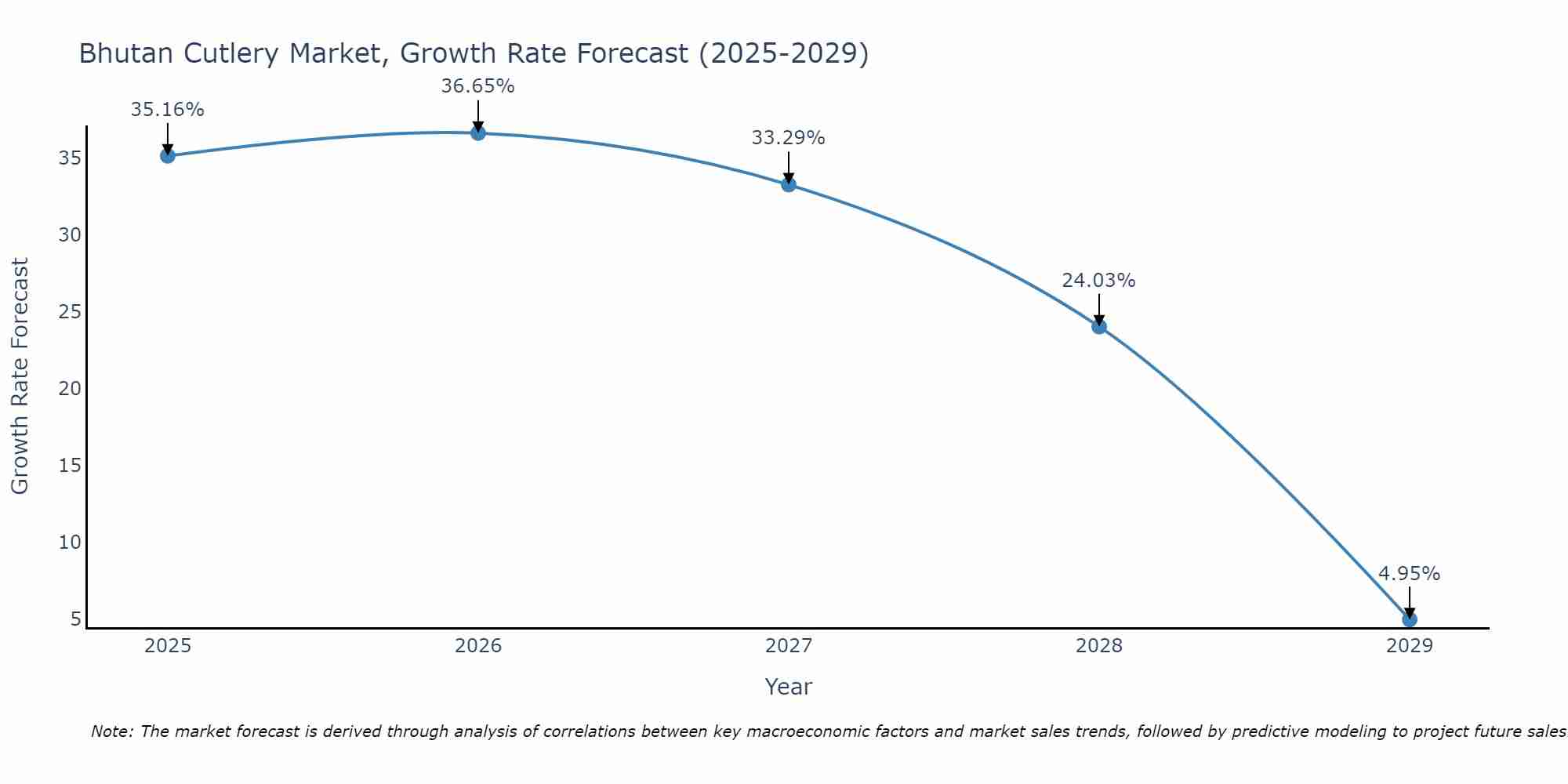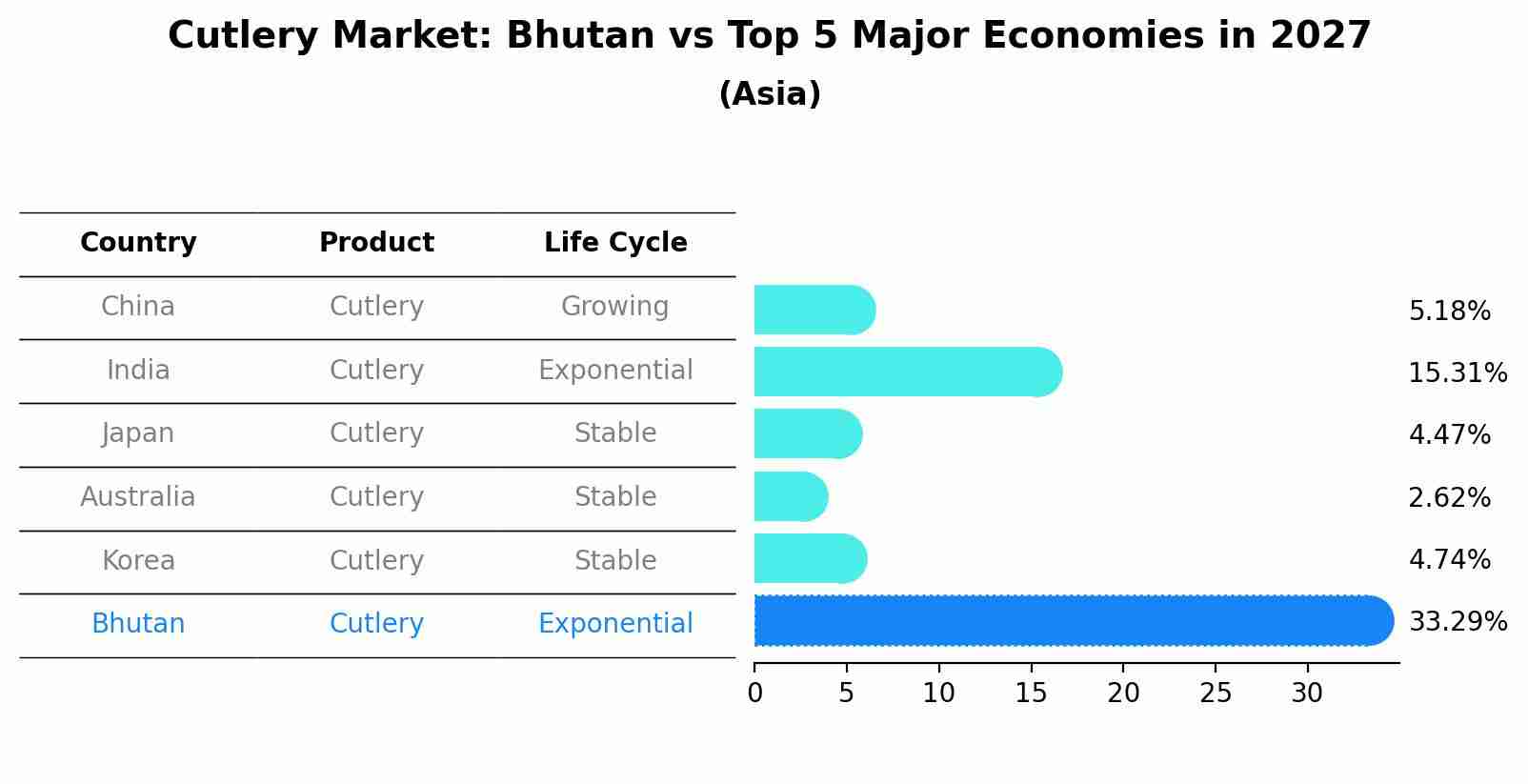Bhutan Cutlery Market (2025-2031) | Companies, Outlook, Segmentation, Analysis, Size, Growth, Industry, Trends, Forecast, Revenue, Value & Share
| Product Code: ETC5085660 | Publication Date: Nov 2023 | Updated Date: Sep 2025 | Product Type: Market Research Report | |
| Publisher: 6Wresearch | Author: Sachin Kumar Rai | No. of Pages: 60 | No. of Figures: 30 | No. of Tables: 5 |
Bhutan Cutlery Market Size Growth Rate
The Bhutan Cutlery Market is projected to witness mixed growth rate patterns during 2025 to 2029. Growth accelerates to 36.65% in 2026, following an initial rate of 35.16%, before easing to 4.95% at the end of the period.

Cutlery Market: Bhutan vs Top 5 Major Economies in 2027 (Asia)
The Cutlery market in Bhutan is projected to grow at a exponential growth rate of 33.29% by 2027, highlighting the country's increasing focus on advanced technologies within the Asia region, where China holds the dominant position, followed closely by India, Japan, Australia and South Korea, shaping overall regional demand.

Bhutan Cutlery Market Overview
The Bhutan Cutlery market includes a range of utensils used in dining and food preparation, such as knives, forks, spoons, and specialized tools. This market is influenced by the growing food service industry and increasing consumer spending on kitchen and dining products. As the lifestyle of Bhutanese consumers evolves, there is a rising demand for high-quality, durable, and aesthetically pleasing cutlery. Both traditional and modern designs are gaining popularity, reflecting changing dining habits and preferences. Additionally, the market is seeing growth due to the increasing number of restaurants and hotels in Bhutan.
Drivers of the market
The Bhutan Cutlery Market is driven by the growing dining and hospitality industry in the region. As the number of restaurants, hotels, and catering services increases, so does the demand for high-quality cutlery. Additionally, rising disposable incomes and changing lifestyles are leading to higher spending on dining experiences, which in turn boosts the demand for premium and stylish cutlery. The market is also influenced by trends in home dining and kitchen aesthetics, with consumers seeking cutlery that combines functionality with design.
Challenges of the market
The Cutlery market in Bhutan faces various challenges, including competition from both local and international brands. The presence of cheaper alternatives, especially imports from neighboring countries, puts pressure on local manufacturers. Additionally, there is a lack of awareness about high-quality cutlery options among consumers, which affects demand for premium products. Another challenge is the limited retail infrastructure and distribution channels, which can restrict market reach and growth opportunities. Finally, fluctuating raw material prices can impact production costs and, consequently, product pricing.
Government Policy of the market
The Bhutan Cutlery market is influenced by government regulations that focus on product safety, quality standards, and environmental sustainability. The Bhutanese government has implemented regulations to ensure that cutlery products meet health and safety standards, including hygiene and material quality requirements. Additionally, policies aimed at reducing plastic waste and promoting eco-friendly alternatives have driven the cutlery market towards sustainable and biodegradable options. These policies are part of Bhutan`s broader environmental strategy to minimize waste and encourage the use of sustainable materials.
Key Highlights of the Report:
- Bhutan Cutlery Market Outlook
- Market Size of Bhutan Cutlery Market, 2024
- Forecast of Bhutan Cutlery Market, 2031
- Historical Data and Forecast of Bhutan Cutlery Revenues & Volume for the Period 2021-2031
- Bhutan Cutlery Market Trend Evolution
- Bhutan Cutlery Market Drivers and Challenges
- Bhutan Cutlery Price Trends
- Bhutan Cutlery Porter`s Five Forces
- Bhutan Cutlery Industry Life Cycle
- Historical Data and Forecast of Bhutan Cutlery Market Revenues & Volume By Product Type for the Period 2021-2031
- Historical Data and Forecast of Bhutan Cutlery Market Revenues & Volume By Forks for the Period 2021-2031
- Historical Data and Forecast of Bhutan Cutlery Market Revenues & Volume By Spoons for the Period 2021-2031
- Historical Data and Forecast of Bhutan Cutlery Market Revenues & Volume By Knives for the Period 2021-2031
- Historical Data and Forecast of Bhutan Cutlery Market Revenues & Volume By Others for the Period 2021-2031
- Historical Data and Forecast of Bhutan Cutlery Market Revenues & Volume By Price Range for the Period 2021-2031
- Historical Data and Forecast of Bhutan Cutlery Market Revenues & Volume By Low End for the Period 2021-2031
- Historical Data and Forecast of Bhutan Cutlery Market Revenues & Volume By Medium Range for the Period 2021-2031
- Historical Data and Forecast of Bhutan Cutlery Market Revenues & Volume By Premium for the Period 2021-2031
- Historical Data and Forecast of Bhutan Cutlery Market Revenues & Volume By Material for the Period 2021-2031
- Historical Data and Forecast of Bhutan Cutlery Market Revenues & Volume By Stainless Steel for the Period 2021-2031
- Historical Data and Forecast of Bhutan Cutlery Market Revenues & Volume By Plastic for the Period 2021-2031
- Historical Data and Forecast of Bhutan Cutlery Market Revenues & Volume By Silver for the Period 2021-2031
- Historical Data and Forecast of Bhutan Cutlery Market Revenues & Volume By Others for the Period 2021-2031
- Bhutan Cutlery Import Export Trade Statistics
- Market Opportunity Assessment By Product Type
- Market Opportunity Assessment By Price Range
- Market Opportunity Assessment By Material
- Bhutan Cutlery Top Companies Market Share
- Bhutan Cutlery Competitive Benchmarking By Technical and Operational Parameters
- Bhutan Cutlery Company Profiles
- Bhutan Cutlery Key Strategic Recommendations
Frequently Asked Questions About the Market Study (FAQs):
1 Executive Summary |
2 Introduction |
2.1 Key Highlights of the Report |
2.2 Report Description |
2.3 Market Scope & Segmentation |
2.4 Research Methodology |
2.5 Assumptions |
3 Bhutan Cutlery Market Overview |
3.1 Bhutan Country Macro Economic Indicators |
3.2 Bhutan Cutlery Market Revenues & Volume, 2021 & 2031F |
3.3 Bhutan Cutlery Market - Industry Life Cycle |
3.4 Bhutan Cutlery Market - Porter's Five Forces |
3.5 Bhutan Cutlery Market Revenues & Volume Share, By Product Type, 2021 & 2031F |
3.6 Bhutan Cutlery Market Revenues & Volume Share, By Price Range, 2021 & 2031F |
3.7 Bhutan Cutlery Market Revenues & Volume Share, By Material, 2021 & 2031F |
4 Bhutan Cutlery Market Dynamics |
4.1 Impact Analysis |
4.2 Market Drivers |
4.2.1 Growing demand for unique and traditional Bhutanese cutlery designs |
4.2.2 Increasing trend of dining out and culinary experiences driving the demand for premium cutlery |
4.2.3 Rising disposable income leading to higher spending on luxury dining products |
4.3 Market Restraints |
4.3.1 Limited availability of raw materials for traditional Bhutanese cutlery production |
4.3.2 Intense competition from imported cutlery brands impacting local market share |
4.3.3 Challenges in exporting Bhutanese cutlery due to trade barriers and regulations |
5 Bhutan Cutlery Market Trends |
6 Bhutan Cutlery Market Segmentations |
6.1 Bhutan Cutlery Market, By Product Type |
6.1.1 Overview and Analysis |
6.1.2 Bhutan Cutlery Market Revenues & Volume, By Forks, 2021-2031F |
6.1.3 Bhutan Cutlery Market Revenues & Volume, By Spoons, 2021-2031F |
6.1.4 Bhutan Cutlery Market Revenues & Volume, By Knives, 2021-2031F |
6.1.5 Bhutan Cutlery Market Revenues & Volume, By Others, 2021-2031F |
6.2 Bhutan Cutlery Market, By Price Range |
6.2.1 Overview and Analysis |
6.2.2 Bhutan Cutlery Market Revenues & Volume, By Low End, 2021-2031F |
6.2.3 Bhutan Cutlery Market Revenues & Volume, By Medium Range, 2021-2031F |
6.2.4 Bhutan Cutlery Market Revenues & Volume, By Premium, 2021-2031F |
6.3 Bhutan Cutlery Market, By Material |
6.3.1 Overview and Analysis |
6.3.2 Bhutan Cutlery Market Revenues & Volume, By Stainless Steel, 2021-2031F |
6.3.3 Bhutan Cutlery Market Revenues & Volume, By Plastic, 2021-2031F |
6.3.4 Bhutan Cutlery Market Revenues & Volume, By Silver, 2021-2031F |
6.3.5 Bhutan Cutlery Market Revenues & Volume, By Others, 2021-2031F |
7 Bhutan Cutlery Market Import-Export Trade Statistics |
7.1 Bhutan Cutlery Market Export to Major Countries |
7.2 Bhutan Cutlery Market Imports from Major Countries |
8 Bhutan Cutlery Market Key Performance Indicators |
8.1 Average selling price of Bhutanese cutlery products |
8.2 Number of tourists purchasing Bhutanese cutlery as souvenirs |
8.3 Percentage of restaurants offering Bhutanese cutlery in their dining experiences |
9 Bhutan Cutlery Market - Opportunity Assessment |
9.1 Bhutan Cutlery Market Opportunity Assessment, By Product Type, 2021 & 2031F |
9.2 Bhutan Cutlery Market Opportunity Assessment, By Price Range, 2021 & 2031F |
9.3 Bhutan Cutlery Market Opportunity Assessment, By Material, 2021 & 2031F |
10 Bhutan Cutlery Market - Competitive Landscape |
10.1 Bhutan Cutlery Market Revenue Share, By Companies, 2024 |
10.2 Bhutan Cutlery Market Competitive Benchmarking, By Operating and Technical Parameters |
11 Company Profiles |
12 Recommendations | 13 Disclaimer |
- Single User License$ 1,995
- Department License$ 2,400
- Site License$ 3,120
- Global License$ 3,795
Search
Related Reports
- Vietnam System Integrator Market (2025-2031) | Size, Companies, Analysis, Industry, Value, Forecast, Growth, Trends, Revenue & Share
- ASEAN and Thailand Brain Health Supplements Market (2025-2031) | Strategy, Consumer Insights, Analysis, Investment Trends, Opportunities, Growth, Size, Share, Industry, Revenue, Segments, Value, Segmentation, Supply, Forecast, Restraints, Outlook, Competition, Drivers, Trends, Demand, Pricing Analysis, Competitive, Strategic Insights, Companies, Challenges
- ASEAN Bearings Market (2025-2031) | Strategy, Consumer Insights, Analysis, Investment Trends, Opportunities, Growth, Size, Share, Industry, Revenue, Segments, Value, Segmentation, Supply, Forecast, Restraints, Outlook, Competition, Drivers, Trends, Demand, Pricing Analysis, Competitive, Strategic Insights, Companies, Challenges
- Europe Flooring Market (2025-2031) | Outlook, Share, Industry, Trends, Forecast, Companies, Revenue, Size, Analysis, Growth & Value
- Saudi Arabia Manlift Market (2025-2031) | Outlook, Size, Growth, Trends, Companies, Industry, Revenue, Value, Share, Forecast & Analysis
- Uganda Excavator, Crane, and Wheel Loaders Market (2025-2031) | Strategy, Consumer Insights, Analysis, Investment Trends, Opportunities, Growth, Size, Share, Industry, Revenue, Segments, Value, Segmentation, Supply, Forecast, Restraints, Outlook, Competition, Drivers, Trends, Demand, Pricing Analysis, Competitive, Strategic Insights, Companies, Challenges
- Rwanda Excavator, Crane, and Wheel Loaders Market (2025-2031) | Strategy, Consumer Insights, Analysis, Investment Trends, Opportunities, Growth, Size, Share, Industry, Revenue, Segments, Value, Segmentation, Supply, Forecast, Restraints, Outlook, Competition, Drivers, Trends, Demand, Pricing Analysis, Competitive, Strategic Insights, Companies, Challenges
- Kenya Excavator, Crane, and Wheel Loaders Market (2025-2031) | Strategy, Consumer Insights, Analysis, Investment Trends, Opportunities, Growth, Size, Share, Industry, Revenue, Segments, Value, Segmentation, Supply, Forecast, Restraints, Outlook, Competition, Drivers, Trends, Demand, Pricing Analysis, Competitive, Strategic Insights, Companies, Challenges
- Angola Excavator, Crane, and Wheel Loaders Market (2025-2031) | Strategy, Consumer Insights, Analysis, Investment Trends, Opportunities, Growth, Size, Share, Industry, Revenue, Segments, Value, Segmentation, Supply, Forecast, Restraints, Outlook, Competition, Drivers, Trends, Demand, Pricing Analysis, Competitive, Strategic Insights, Companies, Challenges
- Israel Intelligent Transport System Market (2025-2031) | Strategy, Consumer Insights, Analysis, Investment Trends, Opportunities, Growth, Size, Share, Industry, Revenue, Segments, Value, Segmentation, Supply, Forecast, Restraints, Outlook, Competition, Drivers, Trends, Demand, Pricing Analysis, Competitive, Strategic Insights, Companies, Challenges
Thought Leadership and Analyst Meet
Our Clients
Industry Events and Analyst Meet
Whitepaper
- Middle East & Africa Commercial Security Market Click here to view more.
- Middle East & Africa Fire Safety Systems & Equipment Market Click here to view more.
- GCC Drone Market Click here to view more.
- Middle East Lighting Fixture Market Click here to view more.
- GCC Physical & Perimeter Security Market Click here to view more.
6WResearch In News
- Doha a strategic location for EV manufacturing hub: IPA Qatar
- Demand for luxury TVs surging in the GCC, says Samsung
- Empowering Growth: The Thriving Journey of Bangladesh’s Cable Industry
- Demand for luxury TVs surging in the GCC, says Samsung
- Video call with a traditional healer? Once unthinkable, it’s now common in South Africa
- Intelligent Buildings To Smooth GCC’s Path To Net Zero


















